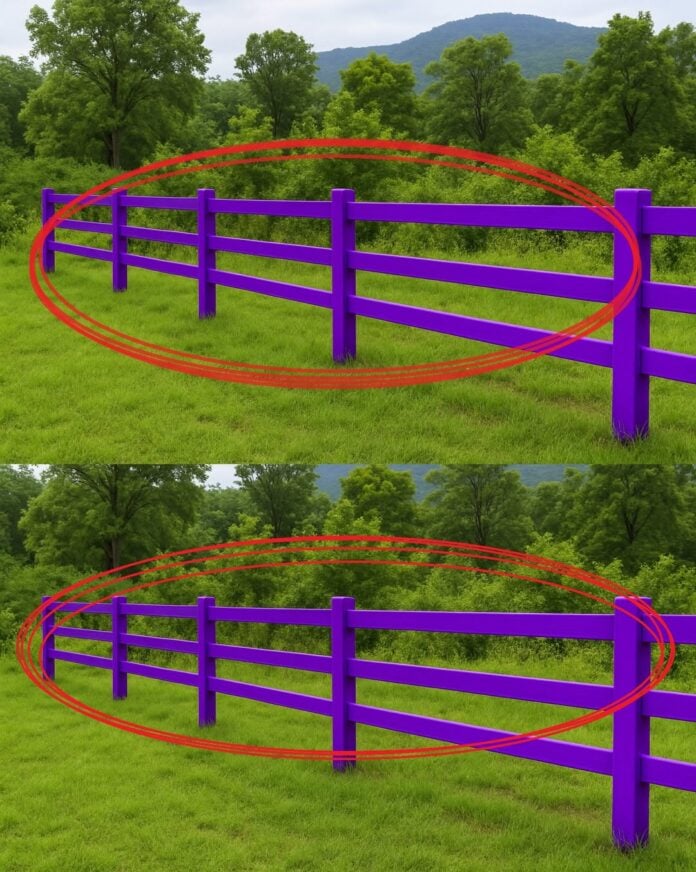You’re walking along a quiet country road or hiking through a trail when something unusual catches your eye — a fencepost painted a deep shade of purple. It’s not a random splash of color, not the handiwork of an artistic farmer with leftover paint, and definitely not a trend in home décor.
That streak of purple paint means something very specific — something every property owner, traveler, and rural wanderer should know.
In many parts of the United States, a purple fence or purple-painted tree is a legal warning: No Trespassing.
The Secret Behind the Purple Fence
For decades, rural landowners struggled with keeping “No Trespassing” signs from falling off, fading in the sun, or being stolen. Replacing them was costly and frustrating. So lawmakers in several states introduced a simpler, smarter solution — one that nature itself couldn’t easily erase: purple paint markings.
In these states, a single purple stripe can carry the same legal weight as a printed sign. If someone crosses the property line beyond it, they can be prosecuted for trespassing just as if they had ignored a posted warning.
Why purple? Because it stands out. It’s bright enough to notice against trees, grass, or fences, yet rare enough in nature that it doesn’t blend in. Unlike red or orange — colors often used for hunting or hazard zones — purple sends a clear message that is distinct, respectful, and unmistakable.
The Rules Behind the Paint
Before you grab a brush and a bucket, it’s important to know that purple paint isn’t meant to be random. States that recognize it have specific rules about how and where to use it.
Here’s what most laws require:
1. Vertical Stripes Only
The mark must be painted vertically — not splashed, not scribbled, not as a design. A vertical stripe is deliberate and signals that it’s meant as a boundary warning, not decoration.
2. Size and Visibility Matter
Each mark should be at least one inch wide and eight inches long, clearly visible from a distance. Anything smaller could be mistaken for a stain or weather damage.
3. Right Height on the Fence or Tree
The paint should be applied between three and five feet off the ground — eye level for most people. Too low, and it disappears in tall grass. Too high, and a hiker or visitor might miss it entirely.
4. Keep It Consistent
Marks are typically placed every 100 feet along property lines or boundaries. This spacing ensures that no one can accidentally wander across without seeing the warning.
These small details are what make the marking legally enforceable — and easy to recognize for hikers, hunters, and neighbors.
States Where Purple Paint Is Law
As of now, more than a dozen U.S. states have adopted the “Purple Paint Law.” Some include:
- Texas
- North Carolina
- Illinois
- Kansas
- Missouri
- Indiana
- Florida
- Pennsylvania
- Arkansas
Each state has its own wording, but the idea is the same: purple paint is a clear, visible boundary marker that carries the same authority as a “No Trespassing” sign.
If you live elsewhere and want to use the system, check with local or county property law before painting. In places without purple paint statutes, it may not have legal power — though it still gets attention.
Why the Purple Paint Law Works
At first glance, painting trees and fences purple might seem a little eccentric, but there’s real logic behind it.
- It lasts longer. Paint doesn’t blow away, rust, or fade as quickly as paper or metal signs.
- It’s cost-effective. A few cans of paint can cover acres of boundary lines for years.
- It’s environmentally gentler. Fewer plastic signs mean less waste and litter on rural land.
- It’s clear but not cluttered. The message is visible without turning a quiet country landscape into a wall of warnings.
For hikers, campers, or explorers, the purple line is also a courtesy. It lets you know where private land begins — helping avoid misunderstandings, potential fines, or uncomfortable encounters with property owners.
The Symbolism of the Color Purple
Interestingly, purple has long symbolized respect, dignity, and protection — qualities that fit perfectly with its modern legal use. A purple mark doesn’t shout “Keep Out” in anger; it quietly says, “This space belongs to someone — please honor it.”
In rural America, property isn’t just land. It’s family history, hard work, and often generations of effort. The purple fence line is a simple, graceful reminder of that.
What to Do If You See a Purple Fence
If you’re out walking or driving and notice a fence, post, or tree marked in purple, remember:
- Don’t cross the line — even if there’s no other sign posted.
- Keep pets, vehicles, and hunting gear on your side of the boundary.
- If you’re unsure whether a trail or field is public, double-check maps or local guidance.
Respecting those purple lines isn’t just about avoiding trouble — it’s about upholding the quiet code of neighborly respect that rural communities still hold dear.
How Homeowners Can Use It Responsibly
If you’re a property owner considering purple paint:
- Choose a long-lasting, weather-resistant exterior paint — ideally one formulated for outdoor fencing or tree marking.
- Mark your boundary lines carefully and consistently.
- Inform nearby neighbors so they know what it means — many may appreciate the clarity.
- Keep a record or photograph of your markings in case questions arise later.
This simple method helps ensure that your boundaries are both legal and easily recognizable to anyone nearby.
The Next Time You See That Color…
So, the next time you’re on a trail and notice a streak of purple on a fencepost or tree, take a moment to pause. You’ve just seen a quiet piece of rural communication — a sign that says this land is cared for, protected, and loved.
It’s not about hostility. It’s about respect.
A purple fence isn’t a strange fashion choice or an oddball decoration. It’s a voice — calm, confident, and centuries old — reminding us that even in a vast landscape, every piece of earth has a story, a steward, and a boundary worth honoring.



